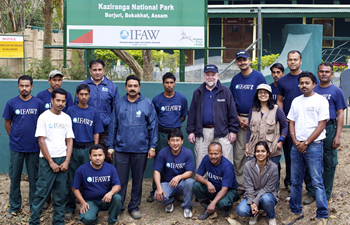In service of nature : CWRC handles 3000 cases in 10 years
The CWRC team today with senior officials from IFAW and WTI
In service of nature: CWRC handles 3000 cases in 10 years
Kaziranga (Assam), December 3, 2012: The Centre for Wildlife Rehabilitation and Conservation (CWRC) completes its 10th anniversary this year, having attended to more than 3000 (of about 150 species) distressed wild animals, essentially handling nearly one case per day since 2002.
Among the Centre’s feats include ensuring all displaced wild rhino calves from Kaziranga National Park returned to the wild, kickstarting the crucial rhino reintroduction in formerly beleaguered Manas National Park. It has also rehabilitated 75% of the displaced elephant calves in Kaziranga back to the wild. Overall, the centre and its subsidiaries have a success rate of more than 60%, saving more than 1600 individual animal lives, including two pairs of extremely rare clouded leopard cubs.
Run by the Assam Forest Department and International Fund for Animal Welfare – Wildlife Trust of India (IFAW-WTI), CWRC was established in August 2002, making it the first wildlife rescue and rehabilitation centre near a protected area in India. The pan-Assam outreach is facilitated by its five fully-equipped Mobile Veterinary Service (MVS) units including one in Diphu supported by Karbi Anglong Autonomous Council, and a CWRC Transit Home in Kokrajhar run with the support of the Bodoland Territorial Council.
An event was organised today in Kaziranga to commemorate the occasion of CWRC’s 10th year.
Shri Rakibul Hussain, Assam Forest Minister, in his message (read out) said: “In our state, flood is natural phenomenon and happens every year. In the past we lost many wild animals due to flood. After we lost many animals in 1998 flood, the Government of Assam decided to have a facility for rescue and treatment of injured and stranded wildlife in Kaziranga. I am very grateful that WTI and its partner IFAW joined hands with the Govt of Assam to set up CWRC – a first of its kind facility in the whole country. I am proud to tell the entire country that through CWRC activities alone we have handled 3000 animals in the last 10 years. That is like attending to a life every day. This is not an easy job. We cannot create life but we can try to save these injured wild animals. All injured animals which were treated at CWRC and released back to their habitat again must have given a big thank you to the dedicated staff of CWRC for saving their lives!”
“I congratulate the entire team of WTI, IFAW and Assam FD for their commendable efforts to save wildlife through CWRC activities in Assam. My best wishes for many more decades of dedicated service by the CWRC in Assam,” the message ended.
Chaired by Shri Joyram Engleng, Chief Executive Member, Karbi Anglong, the event was attended by FD officials, bureaucrats, College of Veterinary Sciences – Khanapara, and local people.
“It is with the support of these people that CWRC is where it stands now. Today as we commemorate its 10th year, we are glad that we have their presence here. Contribution of many more people has been crucial for CWRC’s success, and we would like to take this opportunity to thank them all including the Animal Welfare Division, Ministry of Social Justice and Empowerment and Central Zoo Authority,” said Prof PC Bhattacharjee, Executive Trustee – northeast, WTI.
“IFAW has operational offices in 16 countries across the world, and provides support for conservation and welfare in over 40 countries. The work of CWRC is the most impressive of what we have seen. With this centre, the state of Assam has another thing to be proud of, in addition to its rhinos, and rich natural and cultural heritage,” said Dr Ian Robinson, IFAW Animal Rescue Director.
The event also saw a participation of a contingent of international and national bear experts, who are in Kaziranga currently for the post-IBA 2012 (21st International Conference on Bear Research and Management) conference workshop on bear rehabilitation.
“CWRC proves that long-term rehabilitation (rather than packing them off to zoos) is a viable and preferred option for displaced wild animals. It is not just a welfare institution, but over long-term its cumulative contribution is making an impact on conservation,” said Vivek Menon, Executive Director, WTI and Regional Director – South Asia, IFAW.
“Rhino reintroduction in Manas NP is one example; rehabilitation of clouded leopards and subsequent commitment for additional protection to the release site by local authorities is another. The awareness it has generated, and the trends that it has established – of returning various wildlife species back to the wild in India – will only accrue more benefits for wildlife as time goes by.”









